All you need to know about your products!

| 3DNews Vendor Reference English Resource - All you need to know about your products! |
||||||
 |
||||||
|
|
||||||
"Quiet" is not"slow": a review of video cards with passive cooling systemAuthor:Date: 01/06/2005 The topic of "quiet" computers these days is gaining special urgency for most PC users. The reasons of that may be most varied - starting from personal intolerance to excessive noise up to the discomfort for people around. The industry normally meets the consumer's demands, and nowadays there is a huge number of offerings on the market for those into quietness. Noiseless PSUs, housings, coolers, HDDs... the list is endless. Today, we are reviewing one of the most important component of the PC whose noise can be minimized at will or completely eliminated - on video cards equipped with a passive cooling system. Of course, a video card with passive cooling system is no longer a discovery for anyone - they came into being not today, nor yesterday. The thing is, the noise coming from the cooling system of the video card is among the most priority points at purchase. This issue has now turned especially acute when heat emission of modern (especially, top-end) video cards is so high that to provide the most efficient heat spreader the manufacturers sometimes have to dodge and fit huge mega-structures upon their solutions. These structures may be efficient (far not all, by the way) but their voice is so harsh that turns sensitive users red hot (an not only users). Sure, the lion's share of video cards with passive cooling falls on the low-end and mainstream sectors, whereas in the high-end sector few agree to equip voracious monsters like GeForce 6800 with a passive cooling system (at that we should give credit to Gigabyte which dared for a brave move which resulted in a successful solution, of which you can read in more detail in this material. So, there is a vast choice of quiet cards among varied GeForce 6200 (TC) and Radeon X300 (HM). Quite recently, there have appeared GeForce 6600 with the PCI-E interface which are equipped with a passive cooling system (in this material, two of such cards made by Leadtek and XFX are taking part in the material). There is also RX600XT by GeCube with its own cooling system based on heat pipes, and of course the spice of the show will be video cards by Gigabyte - starting with RX700 LE up to GeForce 6800 AGP. Therefore, we tried to cover quite a great number of "quiet" solutions for both AGP and PCI-E sectors, and for all the price categories. Of course, there rises a reasonable question as to the expediency of such an investigation and its trend. All is simple - the main arguments of those who have doubts as to buying a "quiet" video card are such things like the temperature and overclocking capability. The latter sometimes closely depends on the latter. Therefore, one of the major goals of this investigation is to destroy whatever inadequate rumors of the operating temperatures in video cards equipped with a passive cooling system. Dry figures are sometimes more useful than any verbose reasoning. In this connection, we'll also investigate the overclocking capability of cards equipped with a passive cooling system. Of course, we should take results of these investigations with a pinch of salt - the overclocking capability of each card, along with the temperature, cooling system and other important factors, also depends on each particular specimen. Anyway, these results can be quite of use in order to understand the thing which we used as the title of this article - "quiet" is not "slow". Now let's take a closer look at all our today's heroes. Leadtek PX6600
XFX GeForce 6600
Leadtek PX6200TC 256Mb
XFX GeForce 6200TC 256Mb
Gigabyte GeForce 6200TC 256Mb
ASUS EN6200TC 256Mb
MSI EN6200TC 256Mb
Chaintech GeForce 6200TC 128Mb
Gigabyte GeForce 6800
Leadtek A6200 TDH
XFX GeForce 6200A
Sapphire RX300SE HM 128Mb
ATI RX300SE HM 128Mb
Sapphire RX300SE 128Mb
GeCube RX600XT SilenCool
Gigabyte RX700 PRO
Gigabyte RX700 (LE)
Gigabyte RX800 TurboForce Edition
Test setup
To test the ATI video cards, we used the latest Catalyst 5.5 WHQL-drivers, and ForceWare 76.50 beta drivers - for NVIDIA cards . 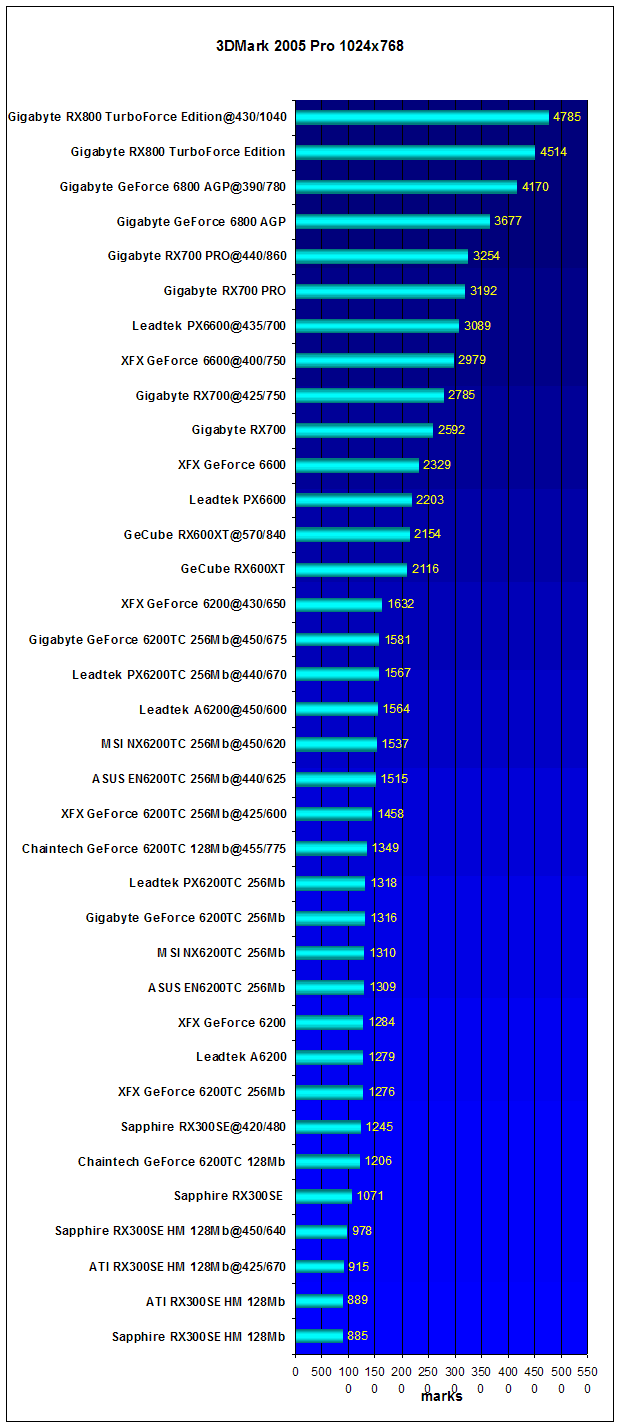 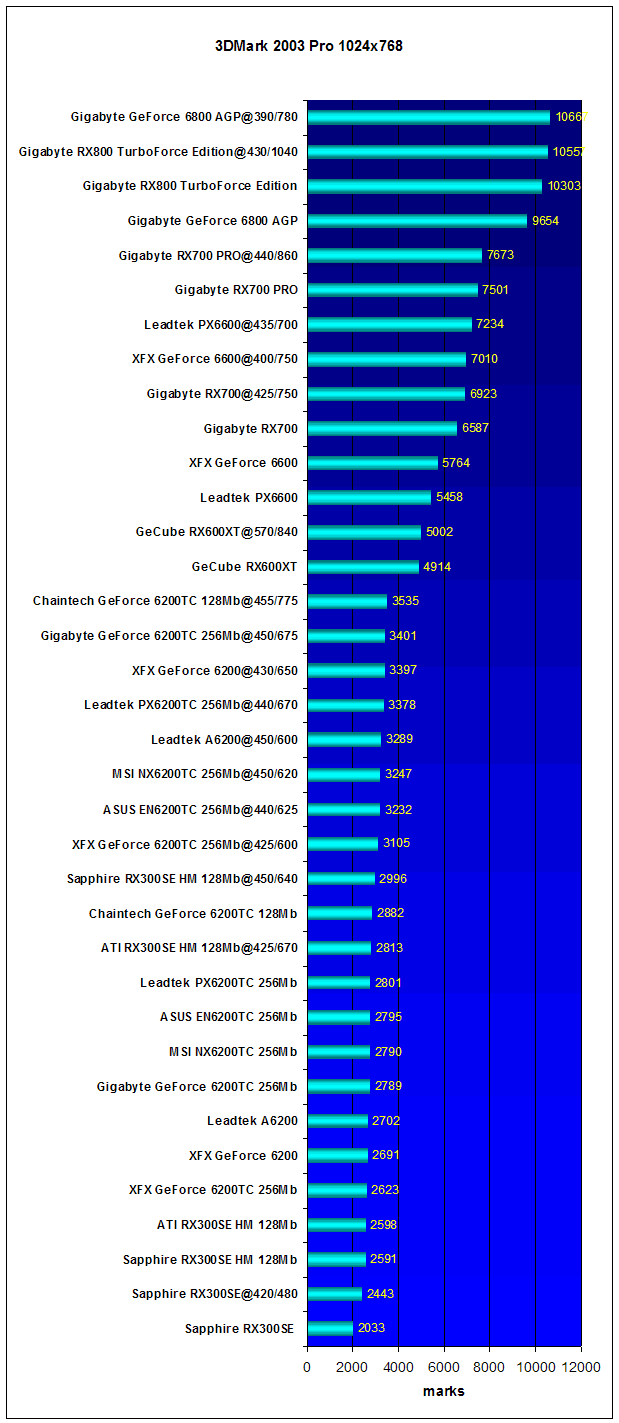 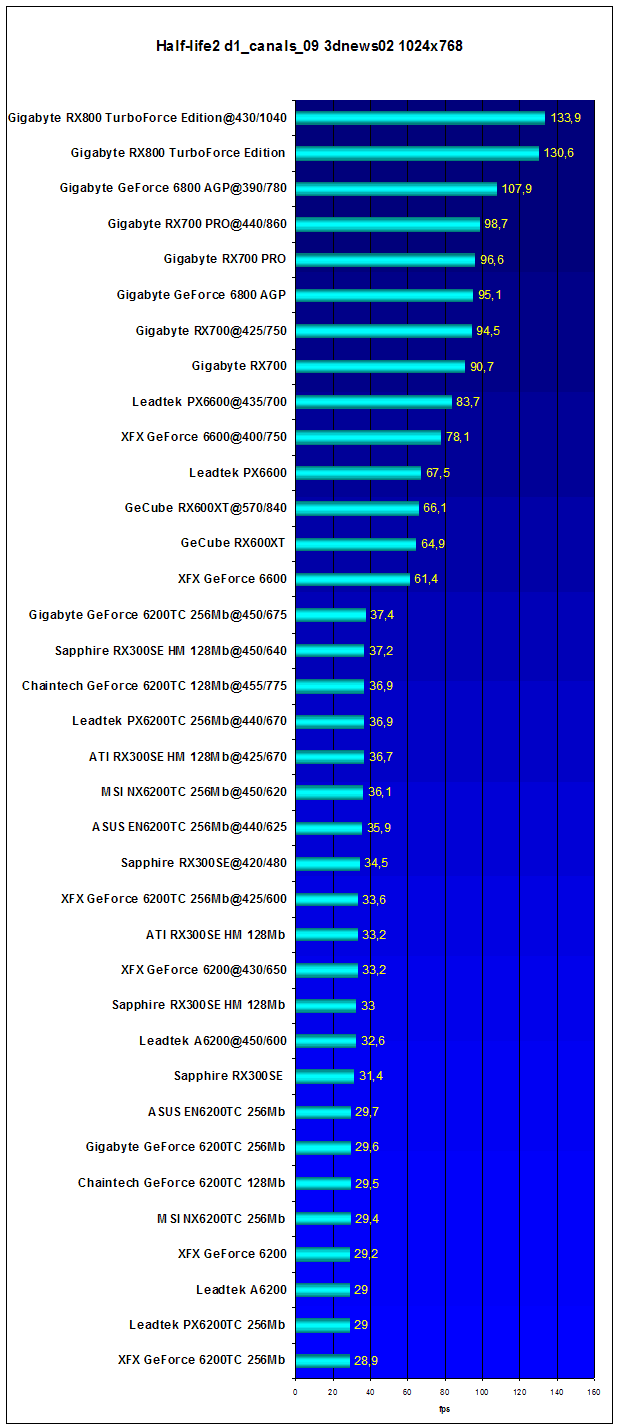 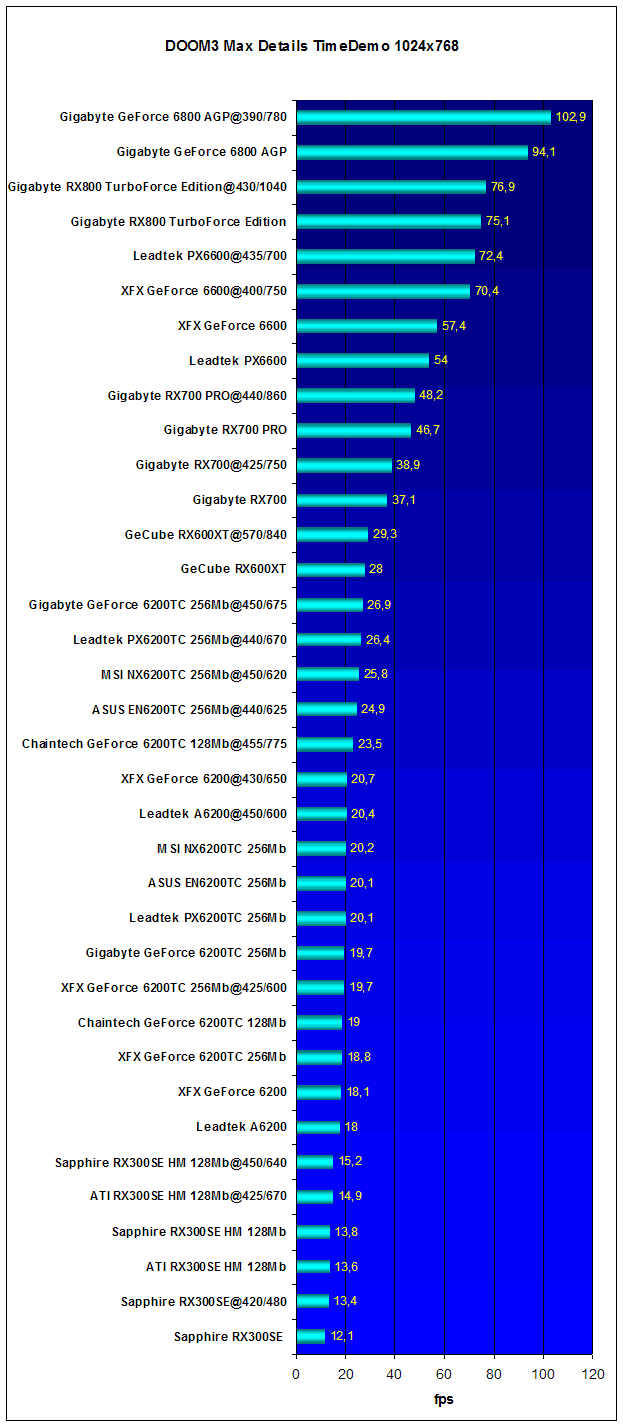 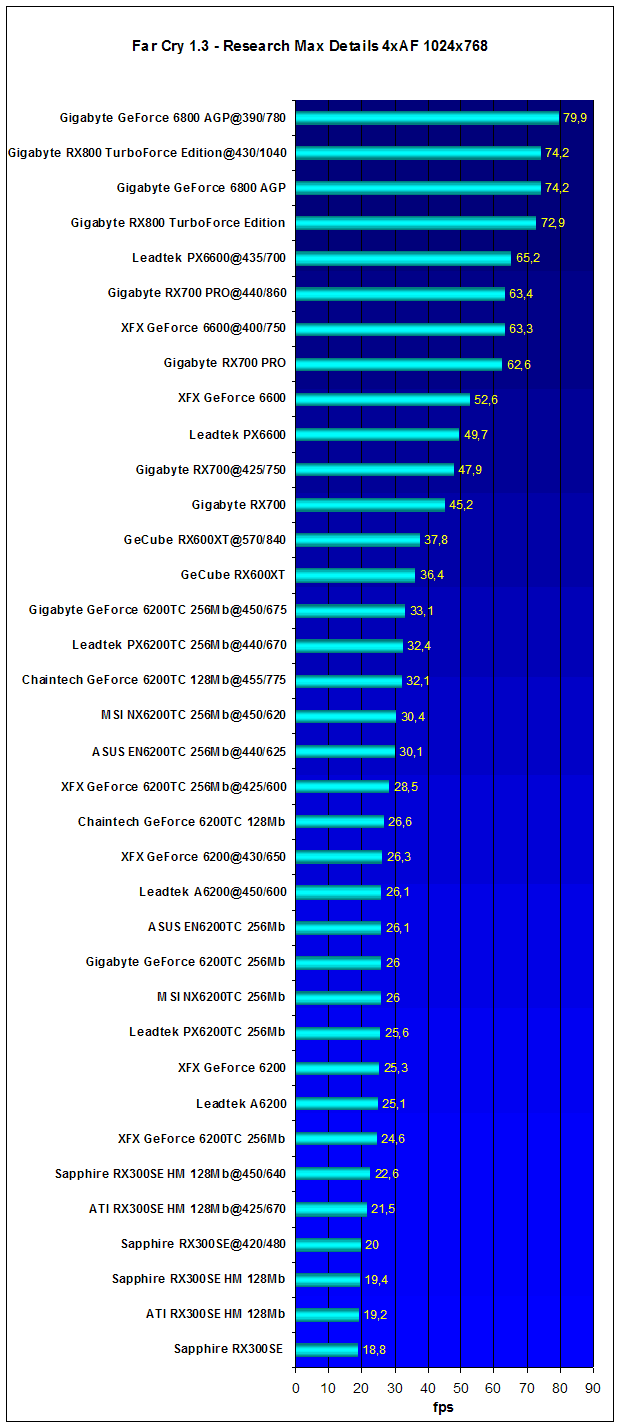 Performance analysis and conclusionsTo start with, we note there won't be any conclusions over here as to comparing the performance of similarly positioned video cards by ATI and NVIDIA. All the solutions presented in this material are not novices on the market, with a rare exception (like the nonstandard GeForce 6600 by XFX), so we'll be talking primarily about what has direct connection to the topic of this material - advantages and shortcomings of video cards equipped with a passive cooling system. So, the first and the main undisputable advantage is the quietness, of course. Quiet cards are mainly positioned in the cheap and relatively inexpensive market sectors, which we have ensured today through tests of a number of whatever 6200TC and RX300SE. But it will be more difficult for amateurs of expensive and powerful monsters, who at the same time are into quietness. At that, their choice is restricted to merely a few solutions which combine advanced performance and a passive cooling system. It is Gigabyte who dares to run such experiments, for which we give our special gratitude. We also want to destroy the widespread myth of tremendous overheating of video cards equipped with a passive cooling system. Of course, 75 C on Gigabyte GeForce 6800 is a bit too high, but not as much to be mournful. Other boards show even worse results at temperatures - in particular, because of the inadequate contact of the chip to the radiator or other causes. Therefore, a passive cooling system and an adequate operating temperature are quite compatible things. As regards inexpensive cards, there are no problems at that. Note that tests and overclocking of all the cards were done without additional blowing, on a regular test-bench, as usual. At the same time, the ambient temperature in the premises was within 25-27 C. Now, regarding the overclocking. Our research showed that cards with a passive cooling system are able overclocking no worse than their brethren equipped with fans. For the purity of experiments, we made the following trick - instead of the "native" cooling system removed from similar video cards, we fitted radiators with fans. Then we compared the overclocking capability and the temperature. As a result, we arrived at the expected conclusion that overclocking (or its absence, like in the case with RX700 PRO) depends more on the board specimen. In the most difficult cases (like Gigabyte GeForce 6800) , the temperature difference amounts to 5 degrees. Of course, nobody challenges the artful value of cooling systems like Arctic Cooling and the like. Moreover, we are not going to encroach upon the sacred - water-driven cooling systems and the extremes like phase-change systems. But the latter is definitely not for most users, and even the few in numbers amateurs of extreme overclocking will anyway remove the "native" cooling system after purchase of the card, hang it on the wall, and fit something more monstrous and mega-efficient to the board. Compared to most standard batch-produced cooling systems which don't stand out with originality (that especially applies to low-end and mainstream solutions numerous in this material), a passive cooling system won't bring any loss. Even contrary to that - additionally to all the other advantages of a board, we get a free bonus like no noise. Is the bonus really free of charge? If it comes to low-end and mainstream sectors, it definitely is, because in these sectors a solution that differs in price from analogs above some certain limit, becomes of no importance. With 6800 by Gigabyte, it is all normal enough - these days, $300 is an absolutely customary price for cards of the GeForce 6800 class. But Gigabyte RX800 TurboForce Edition is much more expensive than its analogs, which is not because of the passive cooling system but because of the overall nonstandard character of the board since it is an analog to RX800XL. It differs only in the pixel pipelines which are as many as 16 in RX800XL 16, and 12 in RX800. The same is also expected for XFX's nonstandard GeForce 6600 with the video memory frequency increased by 100MHz. Currently, the price for this board is unknown. Finally, we arrive at the conclusion that "quiet" is not "slow", "expensive" or other unpleasant epithets to our ear. Being aware of our need for quietness, manufacturers are trying to make our PC experience as comfortable as possible. |
|
|||||